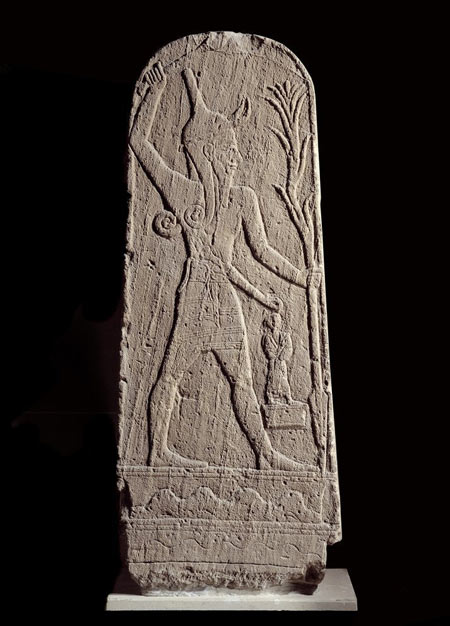Baal

Stele of Baal holding a thunderbolt found in the ruins of Ugarit
Baal was the principal male deity of the Phoenician and Canaanitish nations, while Ashtoreth was the principal female deity. The Bel of Babylon and Assyria has no identity with the Phoenician Baal beyond the fact that they both bore the title of Bel-Ba'ab, meaning "lord". Originally Baal was regarded as a personification of the Sun, the ruler and giver of life in nature, but later his sovereignty in the moral world also was conceived.
The oldest form of the cult of Baal was in the form of nature-worship on the tops of mountains; the Midianites and Amalekites worshipped him on Horeb and Sinai, the Moabites on Mount Peor, the Phoenicians particularly on Cannel, and the Canaanites of the interior on Hermon. There were no representations of Baal, but his presence was symbolized by upright conical stones, which in earlier times were erected in the open air, but later in temples, and are supposed to have had a phallic significance. In contrast to Baal, the genial and fructifying power of nature, stood Moloch, the god of the sun in his destructive side, and the personification of the sterner side of nature. Later, both conceptions were united in the person of Melkart, the supreme god of the Phoenicians. Melkart is usually supposed to mean "king of the city" – i.e. Tyre; others consider it a contraction of two words signifying "king of the earth"; while Selden explained it as equivalent to "strong king". The Greeks confounded Baal or Mel-kart with their own Hercules. and for the purpose of distinction termed him the Tyrian Hercules. From the earliest foundation of Tyre, he seems to have been the tutelar god of that city, and his worship apparently extended from there until it was prevalent in all the towns of the Phoenician confederation, and was established in their remotest colonies, such as Malta, Carthage, and Cadiz. The worship of Baal, with its genial and festive character, had a powerful fascination for the early Israelites before the idea of a pure monotheism had been fully grasped by the popular imagination. Their defection to the worship of Baal-Peor as early as the close of the journey across the desert is related in the Book of Numbers. And after their settlement in Canaan, they returned to it again and again, placing Baal beside Jehovah, and dividing their worship of their own national God with the indigenous god of the country. The influence of King Ahab and his Tynan wife Jezebel spread it over the northern kingdom, in spite of the opposition of the Elijah, but the revolution effected by Jehu banished it from Israel.
The word Baal enters into the composition of many Hebrew, Chaldee, Phoenician, and Carthaginian personal and place-names, such as Jezebel, Hasdrubal, Hannibal, Ethbaal, and Baalbek. The word is also frequently found in conjunction with some epithet, and in such cases appears to have denoted a different deity, though it is possible that it may have been the same person regarded in another aspect, and as exercising merely a different function. Thus, we have Baal-Berith ("the Covenant Lord"), who was specially worshipped by the people of Shechem; Baal-Peor, the Priapus of the Moabites and Midianites; and Beelzebub, or Baalzebub ("the Fly god"), the idol of the Philistines at Ekron, where he had a temple. The Celtic deity Beal was often confounded with Baal by earlier mythologists.
